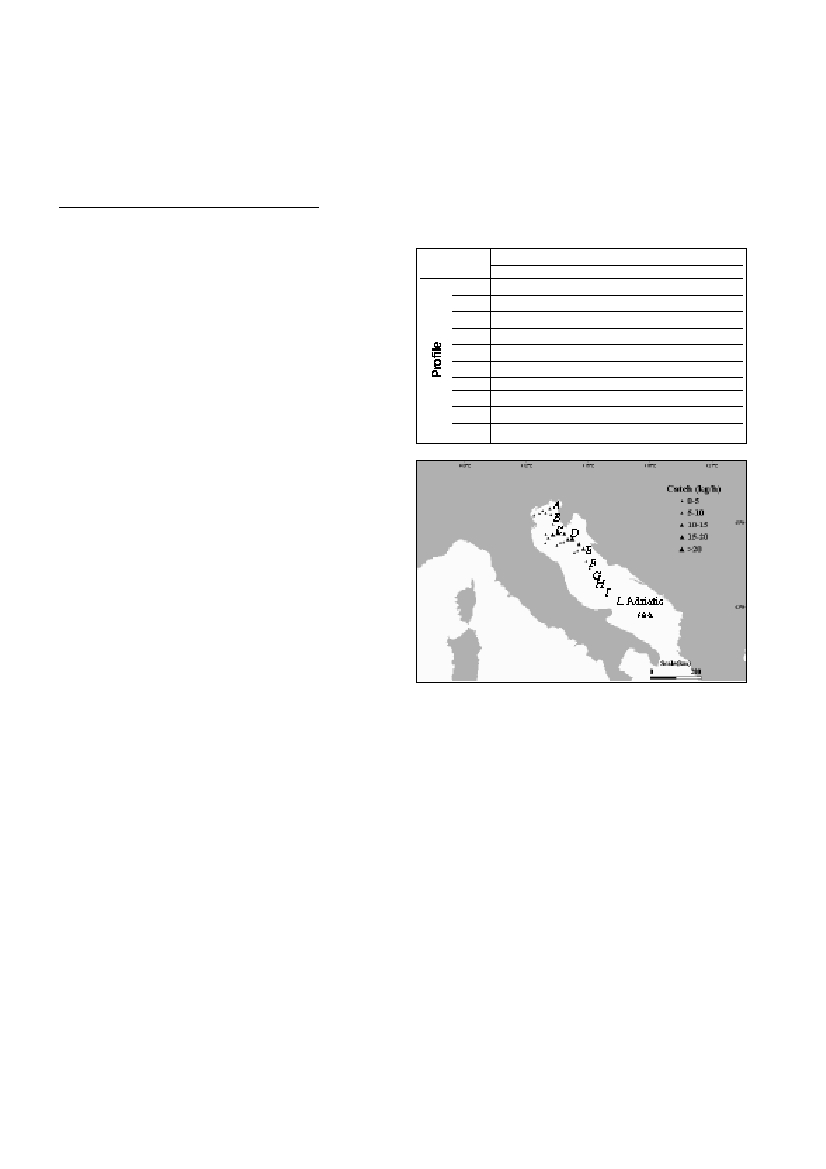Rapp. Comm. int. Mer Médit., 36,2001
235
Introduction
Expedition HVAR reports present data about non edible bycath on
each investigated stations (1). Only genus Holothuriacan be found on
the list, so we don't have any data about species Holothuria tubulosa.
During PIPETA expedition for the first time non edible trawl bycatch
is completely analysed in the Adriatic Sea. Catch of the species
H.tubulosabased on PIPETA expedition (1985-1994) results is pre-
sented in this paper. Some results about non edible bycatch during this
expedition are already presented (2, 3, 4).
Material and methods
Italian trawler PIPETA at 10 profiles (A – L) or 50 stations collect-
ed biological material during 11 cruises. Station planning was system-
atic with additional stratification (sediment, depth). The weight of the
bycatch was measured by filling up a plastic box of 50x32x10.5 cm by
the random sample method with epifaunal material collected by the
trawl. The weight of each species was multiplied with the total num-
ber of boxes with epifauna collected during a single bottom trawl haul
and the value was expressed in kg h
-1
. Standard Italian bottom trawl
was used (5).
Results and discussion
On continental shelf species H. tubulosais the most abundant on
“relict” sand (6). The species lives on depths to 100 m (7). The great-
est presence of the species is on depths from 10 to 50 m (6). During
PIPETA expedition the stations of the investigated profiles are situat-
ed at different depths and sediment types. 496 bottom trawl hauls are
elaborated.
Profiles “A”, “B” and “C” are situated in the north Adriatic at few
different sediment types and depths to 50 m. Thus, the catch from the
stations on these profiles depends on sediment type. The greatest catch
was on profile “C” (Table 1). That is because more than half of the sta-
tions on this profile are on “relict” sand. This is the only profile where
the species is caught on clayey silt and silty clay. Considerable catch
was on profile “A” and this is the only profile where the species was
caught on sand-silt-clay sediment. Negligible catch was on profile
“B”. It’s due to fact that almost all stations are on sediments that con-
tain silt and clay.All stations, except one, on profile “D” are situated
at depths from 50 m to 70 m. Value for the average catch on this pro-
file is similar to value for the average catch on profile “A
”
.
Considerably smaller catch was on profiles “E”, “F” and “G”. On pro-
file “F” the species was noted only at two stations on “relict” sand and
depths to 100 m. The species was not caught on profiles “H”, “I” and
“L”. Almost all stations on these profiles are on depths more than 100
m and on clayey silt and silty clay sediment. Stations on these profiles
that are on depth to 100 m are on sediments that are not suitable sub-
strates for H. tubulosaspecies. The greatest amount of the catch on all
profiles was at stations that are situated on “relict” sand and clayey
“relict” sand. On all profiles there were hauls without this species.
Standard deviations show that the species is unevenly distributed on
the investigated profiles (Table 1). ANOVA-test shows that difference
in catch among profiles is significant (p<0.01). Tukey-test shows that
difference in catches between profile “C” and all other profiles is sig-
nificant (p<0.01).
The greatest catches were at stations in the north Adriatic. The
greatest value for the catch during one haul was at station “C6”
(116.25 kg h-1). Average values above 10 kgh-1 were at following sta-
tions: “C5”, “C6”, “C7”, “D7”, “E6” and “E7” (Figure 1).
Table 1. Catch of the species H. tubulosaon profiles during
PIPETAexpedit
i
o
n
.
Figure 1. Catch of the species H. tubulosaat PIPETAexpedition
stations.
References
1 - Karlovac O., 1959. Istrazivanja naselja riba i jestivih beskraljesnjaka
vucom u otvorenom Jadranu. Izvjesca 5 (1): 1-203.
2 - Jukic S. and Simunovic A., 1982. Relationship between edible and
non edible (epifauna) trawl catch abundances over the Adriatic
continental shelf. Atti del I. Seminario Italiano sui censimenti faunistici,
Urbino: 326-336.
3 - Simunovic A. and Jukic S., 1983. Quantitative and qualitative
relationship between demersal resources of the Adriatic in connection to
bottom sediments and sea depth. FAO Fish. Rep., 290: 187-190.
4 - Simunovic A., 1997. Quantitative and qualitative investigations of
benthic communities in the areas of mobile bottoms of the Adriatic Sea.
Acta Adriat., 38 (1): 77-194.
5 - Piccinetti C., 1972. FAO Catalogue of fishing gear designs: p. 42.
6 - Simunovic, A., Piccinetti C., Bartulovic M. and Grubelic I., 2000.
Distribution and abundance of the species Holothuria tubulosaGMELIN,
1788 and Holothuria forskaliDELLE CHIAJE, 1823 (Holothuria,
Echinodermata) in the Adriatic Sea. Acta Adriat., 41 (2): 3-16.
7 - Zavodnik D. and Simunovic A., 1997. Beskraljesnjaci morskog dna
Jadrana. Svjetlost, Sarajevo, p. 147.
CATCH OF THE SPECIESHOLOTHURIA TUBULOSA GMELIN,
1788 ON CONTINENTAL SHELF IN THE ADRIATIC SEA
Marija Bartulovic, Ante Simunovic and Ivana Grubelic*
Institute of Oceanography and Fisheries, Split, Croatia - bartulovic@izor.hr
Abstract
This paper presents data about catches of the species Holothuria tubulosaGmelin during PIPETA expedition (1985-1994) on 10 profiles
or 50 stations on continental shelf in the Adriatic Sea. 496 bottom trawl hauls are elaborated. The greatest amount of the catch on all
profiles was at stations that are situated in the north Adriatic on “relict” sand and clayey “relict” sand at depths to 50 m.
Keywords: Holothuria tubulosa, catch, Adriatic Sea
PIPETA
Catch (kg h
-1
)
nminmaxxs
A54019.202.344.06
B4400.080.000.0
C650116.259.1518.19
D62022.502.494.95
E55012.000.532.23
F5401.170.020.16
G5001.010.020.15
H3300
00
I4000
00
L3900
00

